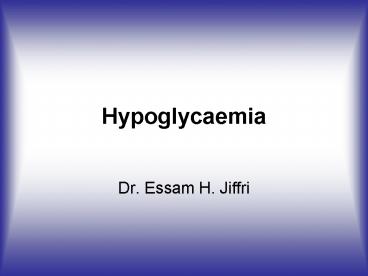Hypoglycaemia - PowerPoint PPT Presentation
Title:
Hypoglycaemia
Description:
Hypoglycaemia Dr. Essam H. Jiffri INTRODUCTION -Hypoglycaemia is defined as a fasting venous whole-blood glucose level of less than 2.2 mmol/L (plasma glucose – PowerPoint PPT presentation
Number of Views:83
Avg rating:3.0/5.0
Title: Hypoglycaemia
1
Hypoglycaemia
- Dr. Essam H. Jiffri
2
INTRODUCTION
- -Hypoglycaemia is defined as a fasting venous
whole-blood glucose level of less - than 2.2 mmol/L (plasma glucose lt2.5 mmo1/l),
when measured by a - glucose-specific ( enzymatic) method.
- -Hypoglycaemia is dangerous because glucose is a
vital primary fuel for the brain.
3
INTRODUCTION
- -Deficiency produces disordered function and, if
prolonged or severe, can cause tissue damage
or death. - -In fasting, the brain still has an energy
requirement equivalent to 80 g glucose 24/h, - which cannot be provided by NEFA, the
immediately available alternative fuel. - -The brain can utilize ketone bodies but these
are not produced rapidly enough to protect
against acute hypoglycaemia.
4
Clinical Features
- -Symptoms fall into two main categories
- -In early acute hypoglycaemia include
nervousness, weakness, headache, sweating,
dizziness, tremor, tachycardia, palpitations,
anxiety and hunger).
5
Clinical Features
- -Those caused by dysfunction of the central
nervous system (neuroglycopaenia), - include visual symptoms, headache, blunted
mental, loss of motor function, confusion,
abnormal behavior and loss of consciousness.
6
Causes
- -It has been traditional to classify
hypoglycaemia as conditions that produce low
blood glucose levels during fasting. - -An alternative approach is based on the
pathophysiology of hypoglycaemia, particularly
reduced gluconeogenesis and increased utilization
of glucose.
7
Causes
8
CAUSES
- I-Decreased Output of Glucose
- -Hypoglycaemia may result from impaired
glycogenolysis or reduced gluconeogenesis. - -Gluconeogenesis may be impaired because of
reduced formation from amino acids - and glycerol.
9
I-Decreased Output of Glucose
- Liver Disease
- -Hypoglycaemia might be expected to be a
complication of liver disease because - of the role of this organ in gluconeogenesis
- Alcohol Abuse
- -Alcohol inhibits gluconeogenesis following
alcohol ingestion.
10
I-Decreased Output of Glucose
- Inherited Metabolic Disorders
- - Endocrine Disease
- -Deficiency of counter-regulatory hormones is
common cause of hypoglycaemia. - -It occurs in cortisol deficiency, due either to
- primary adrenal failure or
- secondary to adrenocorticotrophic hormone (ACTH)
deficiency - -In growth hormone deficiency.
- -Impaired gluconeogenesis is the most likely
reason.
11
CAUSES
- 2-lncreased Glucose Utilization
- Reduced Fat Stores Low
- -Fat stores allow only limited ketogenesis and
this may contribute to hypoglycaemia - in premature infants and in malnutrition.
12
2-lncreased Glucose Utilization
- Decreased Ketone Body Production
- -Continued utilization of glucose by the brain
can cause hypoglycaemia when the - production of ketone bodies is defective.
13
2-lncreased Glucose Utilization
- Impaired Fatty Acid Oxidation Activated
- -Long-chain fatty acids are transported by
carnitine into mitochondria for oxidation, - this being facilitated by two carnitine
acyltransferases, deficiency or inactivity of one
of these enzymes may cause impaired oxidation of
long-chain fatty acids.
14
CAUSES
- 3-Decreased Output and Increased Utilization of
Glucose - Insulin
- -Insulin reduces blood glucose acutely, mainly by
increasing cellular uptake and - utilization therefore excess administration
causes hypoglycaemia. - -Hyperinsulinaemia may also result from
inappropriate endogenous production.
15
3-Decreased Output and Increased Utilization of
Glucose
- Insulin
- -Insulinomas, which are common causes of
hypoglycaemia in adults, are tumours of
pancreatic beta cells. - -Nesiodioblastosis is a diffuse increase in
pancreatic endocrine cells and is an - important cause of hypoglycaemia in infancy.
16
3-Decreased Output and Increased Utilization of
Glucose
- Sulphonylureas
- - Sulphonylureas increase glucose-stimulated
insulin release and hypoglycaemia is the most
commonly observed side-effect.
17
3-Decreased Output and Increased Utilization of
Glucose
- Nonpancreatic Tumour
- - Some nonpancreatic tumours, particularly
primary liver carcinomas, occasionally - cause hypoglycaemia.
18
3-Decreased Output and Increased Utilization of
Glucose
- Postgastrectomy
- - Hypoglycaemia is 2h after a meal rich in
carbohydrate is common in patients with - a partial gastrectomy.
- - It occurs because of rapid passage of sugar
into the small intestine and enhanced release of
enteric hormones which augment glucose-stimulated
insulin release, this excess release of insulin
causes hypoglycaemia.
19
Investigation of Hypoglycaemia in Adults
- - Once the diagnosis is considered blood glucose
and insulin should be measured after an overnight
fast hypoglycaemia with inappropriately high
insulin levels is being demonstrated by such a
protocol in over 90 of cases of insulinoma.
20
Investigation of Hypoglycaemia in Adults
- - For some patients an extended fast of up to 72
h is needed, and glucose and insulin
concentration should be determined every 4-6h, or
when the patient has symptoms. - - Hypoglycaemia due to non-islet cell tumours is
usually very severe and tuomours may be detected
by physical examination or imaging techniques.
21
Hypoglacaemia in Infancy and Childhood
- Hypoglycaemia often occurs at birth, as normal
blood control is established after a few days of
birth.
22
Investigation of Hypoglacaemia in Infancy and
Childhood
- - minimum investigations are
- - blood glucose
- - serum insulin, and
- - blood or urinary ketone bodies.
- - It may be necessary to estimate
- - Growth hormone
- - Cortisol
- - NEFA, and
- - Other intermediary metabolites
23
Hypoglacaemia in Infancy and Childhood
- Most neonates with persistent hypoglycaemia have
hyperinsulinism due to - -Deficiency of counter-regulatory hormone, or
- -An enzyme deficiency affecting gluconeogenisis
or glycogenolysis. - - In older children hyperinsulinism, growth
hormone or cortisol deficiency are important
cause.































